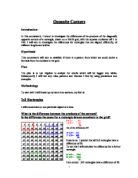The board follows this pattern.
9x9 chessboard
The 9x9 board follows the same pattern as the 8x8.
The 10x10 board follows the same pattern.
The 11x11 board also follows the same pattern as all of the rest.
The 12x12 board also follows the same pattern
The 13x13 board also fit the pattern of the other boards; therefore I will ascertain that there is an algebraic rule for a square board.
The differences will be the key to finding the algebraic rule, however, the differences at the centre won't be very useful because they alternate, and, as rules have to be constant in order to be rules, these differences are useless. The differences at the rim are a different story. They are constant and so will be very useful to finding the rule. The rule has to link the board size into it in order for it to become a universally applicable "nth term" rule. Therefore, I will make board size "n".
Since I am trying to find the number of squares protected by the queen, the perimeter squares will be called "p". Now I have the basis of a rule,
n = p
However, this rule still needs work, as, in the first board size, 8 does not equal 22.
Multiplication will make the numbers more similar.
2x8, 16, isn't big enough, 4x8, 32, is too big, 3x8, 24, is much closer, yet is still too high.
Multiplication isn't the answer this time, division would make it too small, yet subtracting 2 would give me the answer.
3n-2 = p
I will test it with the other board sizes.
(3x9) -2 = 25
27-2 = 25
(3x10) -2 = 28
30-2 = 28
(3x11) -2 = 31
33 -2 = 31
(3x12) -2 = 34
36 -2 = 34
(3x13) -2 = 37
39 -2 = 37
This rule does work. Once you have found out the perimeter the rest of the board follows the pattern illustrated.
EXTENSION WORK
REASON FOR RESULTS
I will position a rook in different positions across the chessboard to test if diagonals are the reason for the varied results across the board. I will only test 8x8, 11x11, and 12x12 boards because these will give me useful and varied results with less hassle. I will start on the 8x8 board.
The results are uniform across the board.
The 11x11 board is also consistent.
The 12x12 board also follows the pattern.
These results, which are consistent regardless of position, prove that the diagonals on a queen are responsible for the target shape pattern of the results.
RECTANGULAR BOARDS
Rectangular boards will have different patterns to square boards and so will have a different algebraic rule for me to find. I will attempt to find this rule by drawing out 9x8, 10x9, and 11x10 boards.
Rectangular boards follow this pattern, which means that only the vertical symmetry of a rectangle can be used to alleviate work.
I will test this pattern on a 10x9 chessboard.
This board also follows the pattern.
I will now test this on an 11x10 board.
The 11x10 board also follows the pattern set by the first board.
These results lead to the possibility of two algebraic rules, but one is more complicated than the other is, so I will go through that one first.
If "n" is the long side, "k" is the short side and "r" is the top row then,
3n +1/2k = r
The complication comes when k is an odd number, because, taking the second board size, 1/2 of 9 is 4.5, but the answer is not 34.5, so you have to round down k to the nearest whole number if it is odd.
Far simpler is this rule if "n" is the short side and "r" is the top row then,
3n -1 = r
which works for all rectangular boards of this shape. Once you have found out the top row the rest of the board follows the pattern illustrated.








